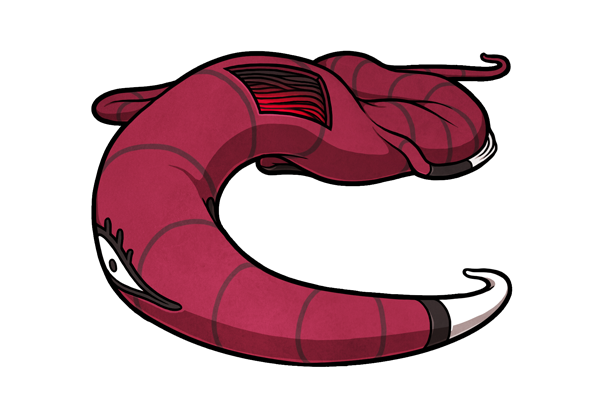

serodromi
the lipred-akacy
prefix sero suffix dromi
cancirou bastion
physical appearance
The serodromi /ˈsɛrədɹoʊmi/ is a mouthless, maroon-colored stranger with white eyes and a white snout, and thin, darker stripes. Its white-tipped limbs are pointed and lack toes. Its skin is smooth and rubbery, and its overall body is highly stretchable, and deforms easily. The serodromi cannot be pulled apart, even when tugged with the strength of a diesel truck. Despite this durability, the serodromi's skin and flesh can be cut with any relatively sharp object, and its dark and foamy, corded inner flesh takes on a waxy consistency when exposed to air. Shallow abrasions, though non-fatal, do not heal, and cuts any deeper than a half-inch or so cause the serodromi's body texture to change and crumble apart within less than a minute.
The serodromi's voice is sing-song in cadence and oiled in tone, its pitch neither masculine nor feminine.
Yanxirio zhab yartixhan, tappizhabri yannabab.

environment and generation
The serodromi has only loose environmental preferences. It appears in both interior and exterior locations, and tends towards dark, soft spaces with quiet and recurring sounds, shaded overhangs, and cool (but not cold) temperatures. The empty cavities at the edges of highways, the garden-lined pathways around certain restaurants, and the utility corridors that link together the buildings of airports or medical facilities are all suitable homes to a serodromi infestation.
When it first appears, the serodromi is thin and ribbon-like, and grows larger based on the number of sensitives within a one to four mile radius. Areas with multiple sensitives will cause the serodromi to swell to full size within several days, whereas serodromi in areas of lower sensitive-density will grow only in periodic bursts over a number of months. In sensitive-absent cities, the serodromi shrivels back to nothing after roughly two weeks of inactivity.
behaviour and effects
The serodromi possesses a mindless but amicable disposition. It is active only in bursts of several hours at a time, during which time it slithers forward as though pulled by the tip of its nose. Its arms drag limply behind it, and these limbs are capable of only weak flopping motions, and only during periods of extreme agitation or excitement in weak actions that never develop beyond these primordial inclinations. Though it usually slithers forward on its belly, it is able to rear itself up to eye level when stationary.
The serodromi shows no preference towards day or night, but tends to stay in the shade whenever possible.
When not on the move, the serodromi "sleeps" by coiling itself around street lamps, sign posts, or any other long, pipe-shaped object, its body tightly stretched.
The serodromi seeks out the company of others of its strain, but does not form groups any larger than seven individuals. When amongst themselves, groups of serodromi cluster together and emit a resonant hum,Ѯ but engage in no direct physical activity beyond shared waking and resting cycles.
Ѯ That sound red-and-deep burgundied into itself more with each second; constant, it sustained, and did not make a ripple on the water in my cup. The park was green, each leaf a vibrant shade of it that did not falter in the shadows...I closed my eyes, and the after-image of each leaf and twig remained, this time in maroon, not ver-dant...
Rey Crud. The Hadrian Manifesto.
interactions with sensitives
The serodromi is drawn to the blood of sensitives, and seeks it out within a quarter-mile radius. It appears attracted to blood only when it is above 90°F in temperature, and thus, by proxy, it usually appears to take a marked interest in sensitives, approaching and following any sensitive that it encounters in an attempt to get as close as possible.
The serodromi fills with blood when around a sensitive, growing fat and saturated. This blood appears duplicated from the sensitive's own blood, with no injury or loss to the sensitive themselves, aside from the slight sensation of fluttering or vibrating just beneath the skin. The serodromi expands at a slow but gradual rate via proximity alone, while physical contact causes it to swell in churning bursts. Insatiable, the serodromi ceases its trailing only when its body is too saturated to allow motion.
When able to, the serodromi will also slither forward into pools of blood, rolling from side to side in order to coat itself with as much blood as possible, even though its slippery surface allows most fluid to slide off easily.
Although docile, the serodromi remains persistent even when attacked, growing incredulous in its motions, but not aggressive in its response. This behaviour, combined with its weak strength, makes it little more than an annoyance.
Despite the serodromi's harmless temperament, prolonged exposure does occasionally cause the gums to bleed, with further encounters raising the probability of this effect.
aging and death
As the serodromi ages, it becomes slower and weaker, able only to drag itself forward in weak tugs. Upon entering this stage, it draws the attention of nearby serodromi, who approach it with curiosity, placing their snouts upon the aging individual's sides, and with a sickening lurch, drain the blood from the target's body. These briefly predatory individuals remain engorged for three days, but return to normal size in the subsequent weeks, appearing neither sated nor disturbed by their companion's death.



